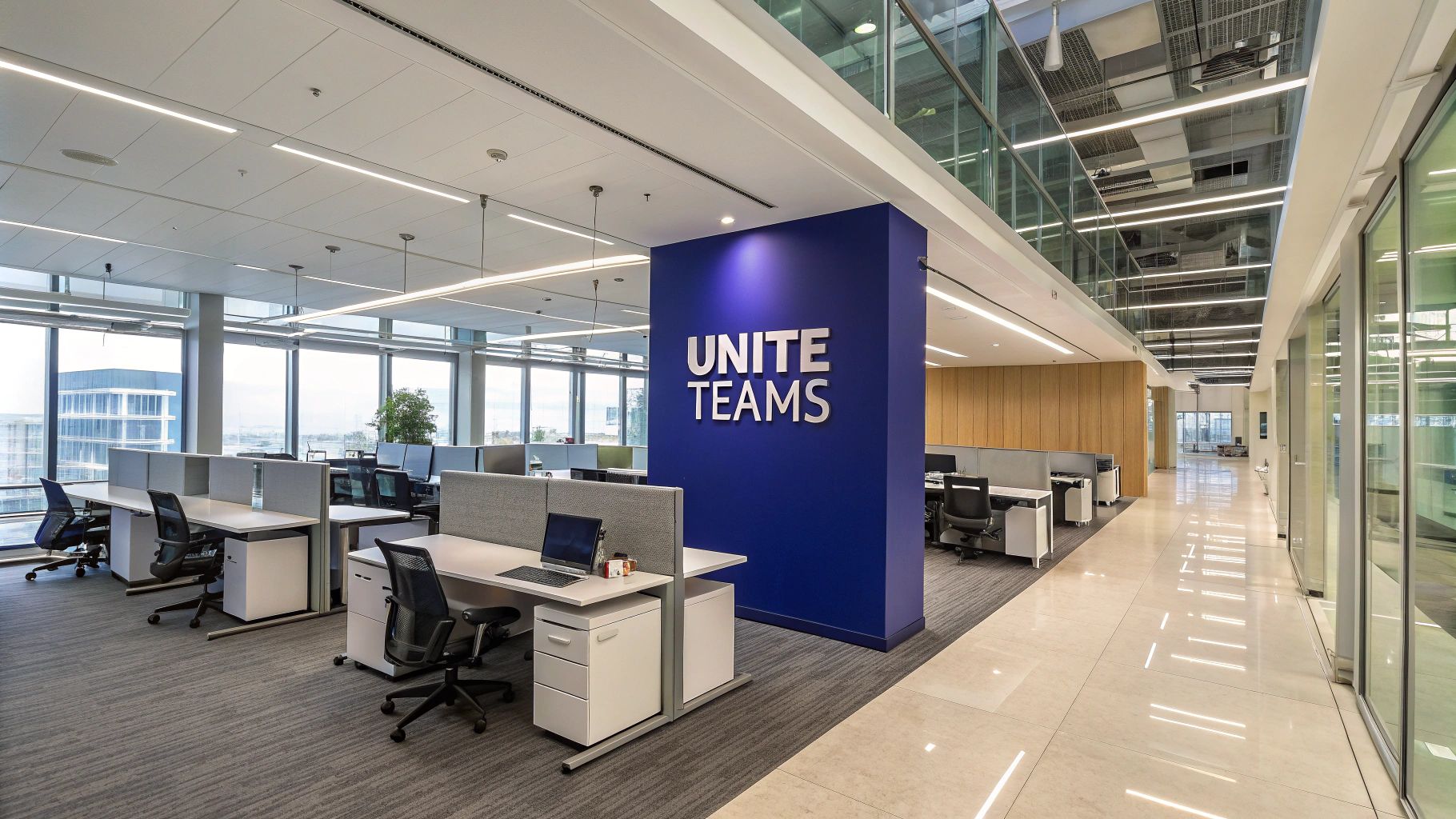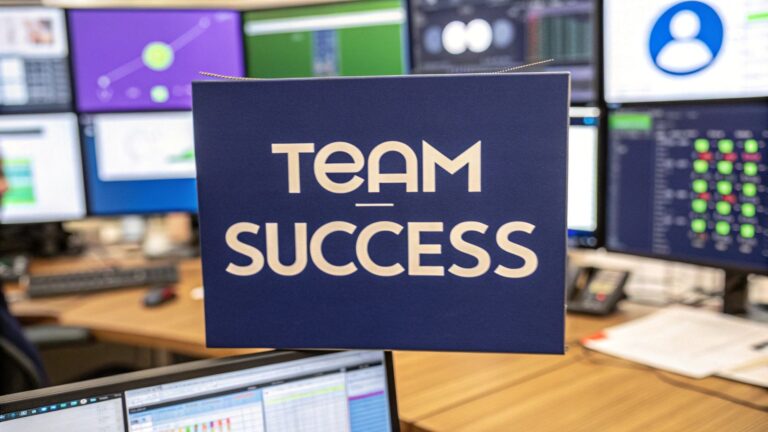The Role of Modern Collaboration Tools

In today's interconnected business world, success hinges on seamless teamwork. The ability for teams to collaborate effectively, regardless of their physical location or department, is paramount. This is where modern collaboration tools come into play, acting as vital bridges connecting individuals and teams to boost communication and ultimately, drive better results. This improved connectivity translates directly into tangible benefits for any organization.
Essential Tools for Enhanced Collaboration
Imagine a complex project involving multiple teams, each juggling its own set of tasks and deadlines. Coordinating everyone without a centralized platform can quickly become overwhelming. Modern collaboration tools provide this essential central hub, offering a single source of truth for all project-related information. This means everyone has access to the most recent updates, documents, and communication threads, minimizing confusion and maximizing efficiency. This streamlined access to information lays the foundation for improved teamwork and faster project completion.
Furthermore, consider the significant impact of real-time communication on collaborative efforts. Instead of relying on lengthy email exchanges or pre-scheduled meetings, teams can utilize instant messaging, video conferencing, and project management software for immediate connection. This allows for quick questions, instant feedback, and rapid decision-making, significantly increasing collaboration efficiency. This accelerated communication flow keeps projects moving forward and prevents delays caused by communication bottlenecks. However, simply having these tools is only the first step.
Leveraging Technology for Seamless Workflow
Having the right tools is important, but true collaboration efficiency comes from actively integrating them into daily workflows. Think of a finely tuned engine: every part needs to work together seamlessly for optimal performance. This means teams need proper training to use the tools effectively and encouragement to adopt them consistently. This consistent adoption is critical. Sporadic use can actually hinder efficiency, creating more confusion than clarity. Much like learning a musical instrument, consistent practice unlocks the tool's full potential. Platforms like BugSmash, for instance, offer a centralized space for feedback and annotation on various media types. This eliminates scattered emails and streamlines the review process, leading to more efficient feedback loops and keeping all stakeholders informed. This, in turn, fosters a more collaborative environment, which brings us to the crucial aspect of effective team communication.
Building Effective Team Communication

As we've seen, collaboration tools are powerful, but their true strength lies in how they enhance communication. Effective team communication is the cornerstone of increased collaboration efficiency. Just as a symphony orchestra requires clear communication between the conductor and musicians, teams need clear and consistent communication to achieve their goals. Therefore, establishing robust communication strategies is paramount.
Clear Communication Channels
This starts with establishing clear communication channels. Just as a conductor uses different gestures to communicate with various sections of the orchestra, teams need to use appropriate channels for different types of communication. For instance, quick questions or updates are best handled through instant messaging, while more complex discussions or project planning should occur in dedicated meetings or project management platforms. This targeted approach ensures efficient information dissemination and prevents crucial details from getting lost. Building upon this foundation, fostering open dialogue is equally important.
Fostering Open Dialogue
Open dialogue is essential for a thriving team environment. Just as a brainstorming session thrives on a multitude of ideas, teams need to feel comfortable sharing their thoughts, opinions, and concerns without fear of judgment. This open environment encourages creativity, problem-solving, and a sense of shared ownership, strengthening team cohesion and driving better results. This collaborative spirit is a key driver of increased collaboration efficiency. But communication is a two-way street.
Active Listening and Feedback
Communication isn't just about talking; it's about truly listening. Active listening—understanding and acknowledging the perspectives of others—is crucial for effective team communication. This involves not just hearing words, but also paying attention to body language, tone, and the unspoken nuances of communication. This deeper understanding builds trust, minimizes misunderstandings, and strengthens interpersonal connections within the team, leading to more productive conversations and increased collaboration efficiency. For more on streamlining feedback, check out our guide on How to Centralize Team Feedback. Beyond verbal communication, other factors also play a role.
The Power of Non-Verbal Communication
Don't underestimate the power of non-verbal communication. Even in virtual settings, elements like video conferencing and emojis can significantly impact meaning and rapport. A simple smile during a video call can foster connection and build trust, while a well-placed emoji can clarify tone and prevent misinterpretations. These subtle cues enhance communication clarity, especially in remote teams with limited face-to-face interaction. By focusing on these principles—clear channels, open dialogue, active listening, and non-verbal cues—teams can transform their communication into a powerful engine for increased collaboration efficiency. This naturally leads us to the important topic of streamlining remote collaboration.
Streamlining Remote Collaboration
Streamlining remote collaboration is no longer a luxury—it's a necessity for increasing collaboration efficiency. Just as a well-maintained car runs smoother, a well-structured remote work environment allows teams to operate at peak performance. This involves optimizing workflows, using the right tools, and fostering a culture of seamless interaction.
Establishing Clear Remote Workflows
Just as a conductor guides an orchestra through a complex piece, clear workflows are essential for guiding remote teams to successful project completion. This starts with establishing clear expectations and responsibilities for each team member. This clarity ensures everyone understands their role and how it contributes to the overall objective. For instance, project management software can be incredibly valuable for assigning tasks, setting deadlines, and tracking progress, providing a shared understanding of project status and increasing collaboration efficiency. This clear structure sets the stage for effective tool utilization.
Tools and Technologies for Remote Success
The right tools and technologies are essential for optimizing remote workflows and facilitating seamless communication. Imagine a construction project without the right tools: progress would be slow and inefficient. Similarly, remote teams need powerful collaboration tools to maximize productivity. This includes video conferencing platforms for face-to-face meetings, instant messaging for quick updates, and file-sharing systems for easy document access, all of which increase collaboration efficiency. Platforms like BugSmash, for example, provide a centralized hub for feedback and annotations, streamlining review processes and further enhancing teamwork. But technology alone is not enough.
Cultivating a Remote-First Culture
Cultivating a remote-first culture is equally crucial for maximizing collaboration efficiency. Think of a high-performing sports team: a strong culture built on trust and mutual respect is essential for success. This means fostering open communication, providing opportunities for social interaction, and actively addressing the unique challenges of remote work. This can be achieved through virtual team-building activities, regular check-ins, and establishing clear communication protocols. These practices build rapport, strengthen team cohesion, and ultimately contribute to increased collaboration efficiency. This naturally transitions to the critical element of project management optimization.
Project Management Optimization
Effective project management is like conducting a symphony, ensuring all the moving parts work together harmoniously to increase collaboration efficiency. This involves selecting the right tools and implementing strategies that foster seamless team coordination and drive projects toward successful completion.
Defining Clear Objectives and Scope
This starts with defining clear objectives and scope. Imagine building a house without blueprints: the result would be chaotic and unsustainable. Similarly, a project without clear goals and boundaries is destined for confusion and inefficiency. The project team must establish a shared understanding of what needs to be achieved, what deliverables are expected, and any existing constraints. This clarity forms the foundation for effective planning, execution, and ultimately, increasing collaboration efficiency.
Breaking Down Complex Projects
Large, complex projects can be broken down into smaller, manageable tasks. This not only makes the overall project less daunting but also allows for accurate progress tracking and identification of potential roadblocks. Just as a map helps navigate a complex journey, a well-defined project plan provides a roadmap for the team, guiding them toward their destination with increased collaboration efficiency. This structured approach facilitates efficient task management.
Task Management and Assignment
Efficient task management and assignment are critical. Assigning the right tasks to the right people, considering their skills and expertise, ensures efficient completion and empowers team members to contribute their best work. This optimized allocation of resources maximizes productivity and significantly increases collaboration efficiency. But assignment is just the beginning.
Tracking Progress and Monitoring Performance
Continuous progress tracking and performance monitoring are essential for maintaining momentum and keeping the project on track. Like a ship's captain constantly monitoring the compass and adjusting course, project managers need to continuously monitor progress, identify deviations, and take corrective action. This proactive approach prevents small issues from escalating into major problems, minimizing delays and maximizing the chances of project success. Learn more in our article about How to Select the Best Project Feedback Tools. Beyond monitoring, adaptability is crucial.
Adaptability and Flexibility
In today's dynamic environment, adaptability and flexibility are paramount. Like a chameleon adapting to its surroundings, project teams need to be prepared to adjust their plans in response to changing circumstances. This means embracing agile methodologies, fostering open communication, and empowering team members to make decisions and adapt as needed. By optimizing these key areas – defining objectives, breaking down projects, assigning tasks, tracking progress, and remaining adaptable – project managers can significantly increase collaboration efficiency. This leads us to the essential topic of cross-functional team integration.
Cross-functional Team Integration

To truly increase collaboration efficiency, organizations must break down departmental silos and foster seamless communication and collaboration across teams. Just as a car engine requires all its components working together, a business unlocks its true potential when departments integrate and collaborate effectively. This cross-functional synergy is vital for increasing collaboration efficiency.
Defining Roles and Responsibilities
This begins with clearly defined roles and responsibilities. Just as each musician in an orchestra understands their part, each member of a cross-functional team needs a clear understanding of their role, responsibilities, and contribution to shared objectives. For example, in a product development team, engineers, marketers, and designers all have distinct roles, but they must work together seamlessly. This clarity is fundamental for increasing collaboration efficiency. This clarity then informs shared goals.
Establishing Shared Goals and Metrics
Establishing shared goals and metrics is crucial. Think of a rowing team: everyone pulls in the same direction towards a common goal. Similarly, cross-functional teams need a shared vision and common metrics to guide their efforts and measure success. This shared understanding keeps everyone focused and aligned, fostering a sense of collective ownership and increasing collaboration efficiency. Effective communication supports these shared goals.
Facilitating Communication and Information Sharing
Shared goals are ineffective without clear communication. Organizations must facilitate clear and consistent communication between departments. Tools like BugSmash are incredibly valuable, providing a centralized platform for feedback, annotations, and communication across teams. This prevents information silos and fosters transparency, increasing collaboration efficiency. For example, marketing teams can use BugSmash to provide direct feedback to designers on website mockups, streamlining the review process. This direct communication creates a collaborative environment. Beyond tools, organizational culture is key.
Fostering a Culture of Collaboration
Fostering a culture of collaboration is essential. Like a successful sports team with strong team spirit and mutual support, organizations need to value and reward collaboration to break down silos and encourage teamwork. This involves recognizing collaborative successes, providing cross-departmental interaction opportunities, and promoting shared responsibility. This positive environment nurtures innovation and drives productivity. This leads to the question of how to measure collaboration's success.
Measuring Collaboration Success
Measuring the effectiveness of collaboration efforts is essential. Just as a coach analyzes game statistics, businesses need to track metrics to increase collaboration efficiency and ensure their strategies deliver results. This involves identifying the right metrics, setting benchmarks, and using data to refine processes.
Key Metrics for Evaluating Collaboration
This starts with selecting appropriate metrics. Just as a doctor uses different instruments for different vital signs, businesses need various metrics for a holistic view of collaboration effectiveness. Tracking completed projects within a timeframe provides insights into team productivity. Measuring time spent on tasks can reveal workflow bottlenecks and areas for improvement. This targeted approach allows for pinpoint improvements in efficiency.
Qualitative Indicators of Success
Quantitative metrics don't tell the whole story. Like a teacher using test scores and class participation, businesses need qualitative indicators too. Feedback surveys provide valuable insights into team morale, communication effectiveness, and satisfaction. This qualitative data adds context to the quantitative metrics, providing a nuanced understanding of team dynamics. This holistic approach is essential for informed decision-making.
Utilizing Data to Drive Improvement
Collecting data isn't enough. Businesses need to analyze collaboration data to identify trends, patterns, and areas for improvement. This data-driven approach allows for informed decisions, refining strategies, optimizing workflows, and investing in tools that truly increase collaboration efficiency. For example, if data reveals communication bottlenecks, a business might invest in a platform like BugSmash to streamline feedback. This proactive approach maximizes efficiency. This brings us to the future of workplace collaboration.
Future of Workplace Collaboration
This discussion of measuring collaboration success paves the way for exploring the future of workplace collaboration. Emerging technologies are transforming how we work together, promising to further increase collaboration efficiency, break down geographical barriers, and unlock new levels of productivity.
The Rise of Artificial Intelligence
Artificial intelligence (AI) is significantly shaping the future of collaboration. Like a personal assistant anticipating needs, AI-powered tools automate routine tasks, analyze data, and provide insights for better decision-making. This frees up teams to focus on strategic work. For example, AI can facilitate meeting scheduling, transcribe conversations, and summarize discussions, significantly increasing collaboration efficiency. Beyond AI, other technologies are emerging.
Virtual and Augmented Reality: Transforming Collaboration
Virtual and augmented reality (VR/AR) are revolutionizing team interaction. Imagine architects walking through a virtual building design together or engineers collaborating on a complex repair in augmented reality. These immersive technologies offer unprecedented opportunities for remote teams to connect and collaborate as if physically present. This enhanced presence can significantly improve communication and problem-solving.
The Metaverse and the Future of Work
The metaverse, a persistent, shared virtual world, has the potential to transform the workplace. Imagine attending a virtual conference with interactive exhibits or collaborating on a project in a virtual office with global colleagues. This enhanced connection can foster stronger community and boost creativity. But technology is only part of the equation.
The Human Element: The Importance of Connection
Technology is simply a tool. The human element—connection, empathy, and trust—remains fundamental to effective collaboration. As technology evolves, it's essential to prioritize strong relationships, open communication, and psychological safety. This means investing in team-building, promoting active listening, and encouraging open dialogue. These human-centric practices, combined with technology, will unlock unprecedented levels of collaboration efficiency.
Ready to dramatically increase your team's efficiency? Start your free trial of BugSmash today and transform your workflow. Try BugSmash now!





Pingback: BugSmash: The Collaboration Space for Creative Teams – Transform Your Creative Workflow – BugSmash Blogs